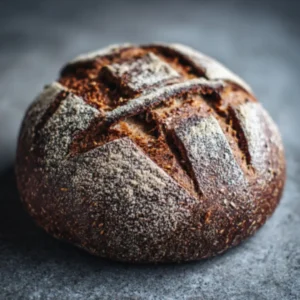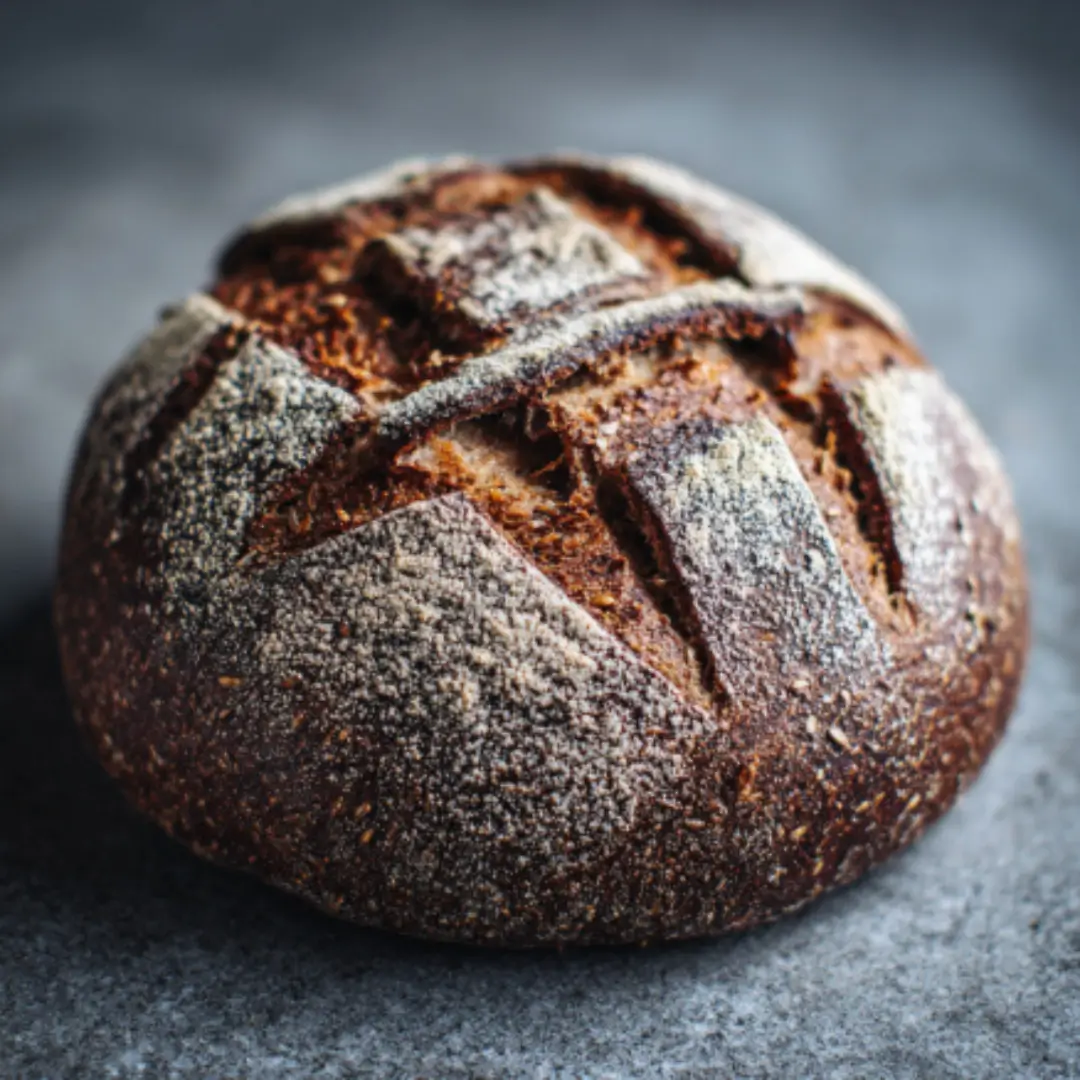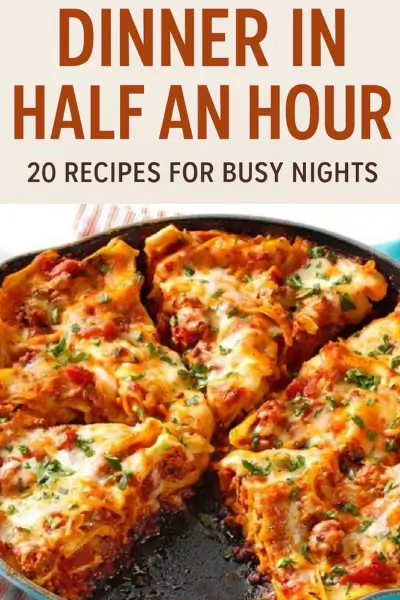Black bread is a rich, dark loaf that’s full of flavor. It has a deep color, a slightly sweet taste from molasses, and a hint of coffee and caraway seeds. You can make it with carrots or potatoes, and it always turns out hearty and satisfying.
Why We Love This Black Bread Recipe
This black bread is more than just a recipe — it’s a ritual that connects you to generations of bread makers. You love the way molasses adds a dark hue and deep sweetness. The espresso and cocoa enrich the bread with complexity, while the carrots add tiny bursts of color and moisture throughout. This isn’t your everyday loaf — it’s a wholesome, flavorful centerpiece that brings warmth to any meal. The slow rising process might take some patience, but the result is deeply rewarding.
Ingredients About Black Bread
- 2 1/4 teaspoons active dry yeast
- 320 – 400 ml warm water (105 – 115°F)
- 1 teaspoon natural cane sugar or brown sugar
- 2 tablespoons cocoa powder
- 2 tablespoons finely ground espresso beans
- 1/4 cup (70 ml) molasses (or substitute with black treacle or honey)
- 3 teaspoons caraway seeds, plus more for topping
- 3 tablespoons unsalted butter, cut into pieces
- 2 teaspoons fine grain sea salt
- 2 cups (150 g) coarsely grated carrot (or substitute with cooked, mashed potato)
- 1 1/3 cup (150 g) rye flour
- 3 1/4 cup (425 g) bread flour or unbleached all-purpose flour, plus more for dusting
- Olive oil (for kneading and greasing the baking sheet)
- 2 tablespoons buttermilk, water, or milk (for brushing the loaf)
How to Make Black Bread Directions
Begin by preparing your yeast. In a small bowl, whisk the yeast with about 1 1/3 cups of warm water and a teaspoon of sugar. Let it rest until it becomes foamy. This step is essential to activate the yeast and ensure your dough rises beautifully.
While the yeast is waking up, combine the cocoa powder, finely ground espresso beans, molasses, caraway seeds, butter, and salt in a small saucepan over medium-low heat. Stir constantly until the butter melts and the ingredients blend into a smooth, warm mixture. Make sure this mixture cools slightly before moving to the next step.
In a large mixing bowl, combine the foamy yeast, the grated carrots (or potatoes), and the warm molasses mixture. Stir everything together. Slowly add in the rye flour and bread flour. You want the dough to come together as a soft, slightly tacky ball. Adjust with more water if it feels dry or a bit more flour if too sticky.
Now comes the hands-on part. Turn the dough out onto a lightly floured surface and knead it for about 5 minutes until it becomes smooth, elastic, and springy. If you have a stand mixer with a dough hook, this step can be done there too.
Shape the kneaded dough into a round ball. Rub a bit of olive oil over it and place it seam-side down into an oiled bowl. Cover it loosely with a cloth or plastic wrap, and let it rest in a warm place until it increases in size by about half. This takes one to two hours depending on your environment. A warm oven or a sunny spot works well.
Once it has risen, press down gently across the surface to release excess air. Shape it into a neat round loaf and place it on a lightly greased baking sheet. Cover again and let it rise until almost doubled in size.
Preheat your oven to 425°F (220°C). Uncover your loaf, brush the top gently with buttermilk, water, or milk, and sprinkle some flour and extra caraway seeds over it. Score an ‘X’ across the top with a serrated knife to help it expand while baking.
Bake for 20 minutes at the high temperature, then lower the oven to 350°F (180°C) and bake for another 20 to 25 minutes. You’ll know it’s done when the crust is deeply colored and sounds hollow when tapped underneath. Let the bread cool on a wire rack for at least 15 minutes before slicing in.
How to Serve Black Bread
You can serve black bread in so many ways. Its dense, flavorful structure makes it perfect with hearty soups or stews. Slice it thickly and slather it with salted butter, or use it as a base for a savory sandwich with your favorite spread and crunchy vegetables. The slight sweetness pairs well with nut butters or soft cheeses too.
To get creative, try toasting a slice and topping it with avocado, lemon, and chili flakes for a bold breakfast. Or keep it traditional by pairing with a bowl of hot vegetable soup. However you choose to serve it, this bread holds its own and enhances every bite.
Expert Tips: Black Bread
Here are some helpful ideas to make your black bread even better. First, always check the freshness of your yeast. If it doesn’t foam, it won’t rise. Keep your liquids lukewarm to activate but not kill the yeast.
Use carrots for moisture and color, but you can swap in a cooked, mashed potato for a slightly different flavor and texture. Molasses is key for its deep taste, but honey or black treacle work too. Honey makes the bread a bit lighter and sweeter.
Don’t rush the rising process. Giving the dough enough time to develop its flavor is worth the wait. For best results, place your dough near the oven while it preheats or in a sunlit window.
Before baking, don’t skip scoring the top. It lets the steam escape and gives you that artisan-style finish.
How to Store Black Bread
Once your loaf is fully cooled, wrap it in a clean kitchen towel or store it in a bread box. This helps maintain its texture without getting soggy. Avoid plastic wrap, which traps moisture and makes the crust chewy.
You can keep the bread at room temperature for 2 to 3 days. If you need to store it longer, slice and freeze the loaf. Just pop a slice in the toaster or oven whenever you need fresh bread without baking another full batch.
Variation of Black Bread
There are plenty of ways to make this recipe your own. One variation is to substitute grated potatoes for carrots, giving you a slightly different flavor and moisture profile. You can also experiment with the flours. Try a higher percentage of rye flour for a deeper earthiness, or go for whole wheat for added fiber.
If you want more seeds, add sunflower or flax seeds into the dough. For a softer loaf, reduce the bread flour slightly and increase the liquid a little. Play around with brushing the top using oat milk or butter for different finishes.
And if you’re feeling bold, shape the dough into small rolls or a braided loaf. Just adjust the baking time accordingly.
FAQ About Black Bread
Can I make black bread without molasses?
Yes. You can replace molasses with honey or black treacle. Honey will result in a lighter, slightly sweeter bread.
Why is my dough not rising?
This could be due to inactive yeast or water that was too hot or too cold. Make sure your yeast is fresh and water temperature is between 105°F and 115°F.
What flour is best for black bread?
A mix of bread flour and rye flour gives you the best balance of structure and flavor. You can use all-purpose flour if that’s what you have.
How do I know when the bread is baked?
The crust should be firm and slightly darkened. Tap the bottom of the loaf; if it sounds hollow, it’s ready.
Can I freeze black bread?
Yes, slice the bread and freeze it in an airtight container. Toast or warm slices as needed.
How can I make this bread more moist?
Use fresh carrots or potatoes and don’t skip the rising time. Proper hydration and a long rise lead to a moist loaf.
Is black bread sweet or savory?
It leans toward savory with just a touch of sweetness from molasses or honey, making it versatile for any meal.
Can I use a stand mixer for kneading?
Absolutely. Use the dough hook and knead until the dough is elastic and smooth.

Black Bread
Ingredients
- 2 1/4 teaspoons active dry yeast
- 320 – 400 ml warm water (105 – 115°F)
- 1 teaspoon natural cane sugar or brown sugar
- 2 tablespoons cocoa powder
- 2 tablespoons finely ground espresso beans
- 1/4 cup molasses (or substitute with black treacle or honey)
- 3 teaspoons caraway seeds (plus more for topping)
- 3 tablespoons unsalted butter (cut into pieces)
- 2 teaspoons fine grain sea salt
- 2 cups coarsely grated carrot (or substitute with cooked, mashed potato)
- 1 1/3 cup rye flour
- 3 1/4 cup bread flour or unbleached all-purpose flour (plus more for dusting)
- Olive oil (for kneading and greasing the baking sheet)
- 2 tablespoons buttermilk, water, or milk (for brushing the loaf)
Instructions
- In a small bowl, whisk the yeast with about 1 1/3 cups of warm water and a teaspoon of sugar. Let it rest until foamy.
- Combine cocoa powder, espresso, molasses, caraway seeds, butter, and salt in a saucepan over medium-low heat. Stir until melted and blended. Cool slightly.
- In a large mixing bowl, combine foamy yeast, grated carrots (or potatoes), and the warm molasses mixture. Stir together.
- Slowly add rye flour and bread flour to form a soft, slightly tacky ball. Adjust with more water or flour as needed.
- Knead on a lightly floured surface for about 5 minutes until smooth and elastic.
- Shape into a ball, rub with olive oil, and place seam-side down in an oiled bowl. Cover and let rise in a warm place until doubled, about 1-2 hours.
- Once risen, shape into a round loaf and place on a greased baking sheet. Let rise until almost doubled.
- Preheat oven to 425°F (220°C). Brush the top with buttermilk and sprinkle with flour and caraway seeds. Score an ‘X’ on top.
- Bake for 20 minutes, then lower the temperature to 350°F (180°C) and bake for another 20-25 minutes until crust is deeply colored and sounds hollow when tapped.
- Let cool on a wire rack for at least 15 minutes before slicing.
Send me this recipe!
Just enter your email below and get it sent straight to your inbox!


